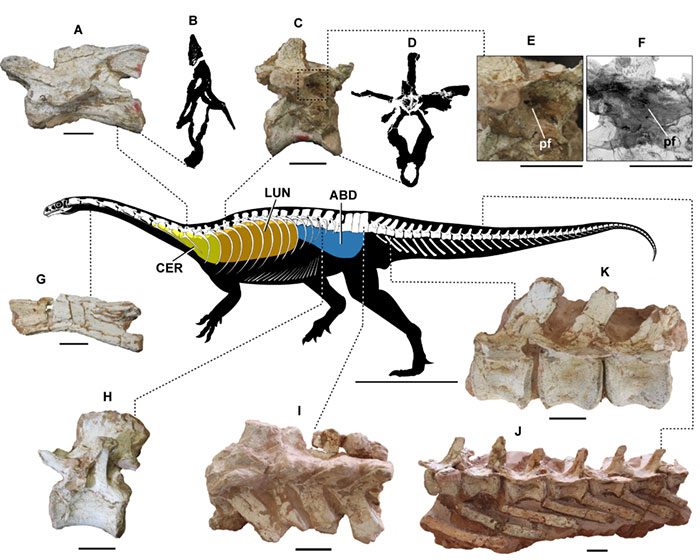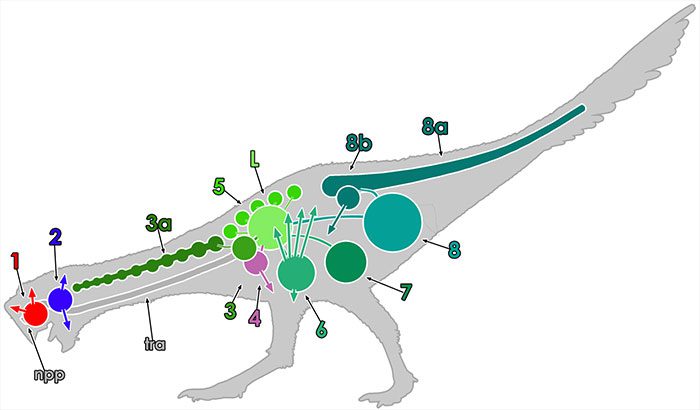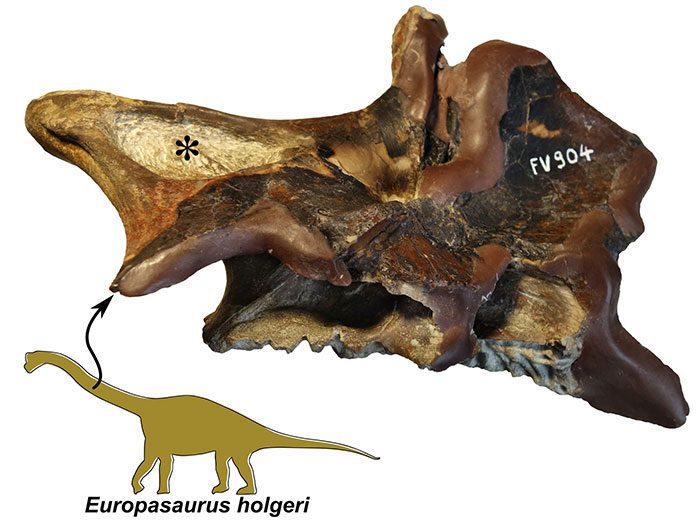Since lungs do not typically survive the fossilization process, one might wonder how scientists can reliably determine anything about the respiratory capabilities of extinct species. The answer lies in their bones.
Somewhere in Earth’s past, certain branches on the tree of life adopted a special method that significantly improved breathing and cooling compared to the way mammals, like ourselves, do it.
At first glance, this development may not seem significant until scientists discovered that it may have existed in some of the largest dinosaurs that our planet has ever known. It was so successful that it was maintained by three different groups of extinct species and continues to exist today in the living descendants of dinosaurs.
In a series of papers published in late 2022 and early 2023, paleontologists examined the microstructure of fossils from some of the earliest known dinosaurs to determine how the original parts of this system developed.

Many of the bones examined in the study were located near the lungs.
In species like birds, this system contains cavities, also known as “air sacs”, located within bones throughout the body. Unlike the breathing process in mammals, where inhalation and exhalation are two separate processes, these bones facilitate unidirectional breathing: inhaling and exhaling simultaneously. Known as pneumatic bones of the postcranial skeleton, they are part of an extremely efficient system that rapidly delivers oxygen into the bloodstream and removes heat from the body.
Today, this air sac system is known only in birds. Birds and crocodiles are both species that originally descended from lizards, the living relatives of dinosaurs and non-avian flying reptiles. Although modern crocodiles have a unidirectional breathing mechanism through their lungs, their ability to process air does not extend to their bones, as they lack any air sac cavities. A paper published in PLOS One in 2012 examined the air sac systems of Triassic dinosaurs, and the authors concluded that: “No lizard in the crocodilian lineage shows clear evidence of the pneumaticity of the postcranial skeleton.”
Tito Aureliano, who was not involved in the aforementioned study, explained the authors’ conclusion: “There are no anatomical signs of any truly pneumatic features related to air sacs prior to the evolution of flying lizards and saurischian dinosaurs.”
He explained that, as mammals, we can become breathless or overheated due to high-intensity physical activity or high temperatures. However, if there were an invasive air sac system, we would not experience such conditions.
So when did these air sacs develop? They were present from about 145 to 66 million years ago in Late Cretaceous theropods (bipedal carnivorous or herbivorous dinosaurs), flying reptiles, and sauropods (gigantic long-necked dinosaurs).

Not all animals use the same techniques and organs to breathe. While humans expand their lungs for respiration, birds have external air sacs to pump oxygen in, so their lungs do not actually move. For a long time, paleontologists believed that all dinosaurs breathed like birds because they had similar respiratory anatomical structures.
Therefore, to uncover their origins, Aureliano, a paleontologist at the Federal University of Brazil in Rio Grande do Norte, is the lead author of three recent papers that looked further back into the Triassic period (about 252 to 201 million years ago).
The research team sought answers based on two types of sauropodomorphs (early sauropods before they evolved into long-necked and gigantic forms) called Buriolestes and Pampadromaeus, and a carnivorous dinosaur named Gnathovorax.
Bone tissue traces in the fossils matched patterns found in living bird species, suggesting the presence of this respiratory adaptation. However, none of the early dinosaurs exhibited these traits, indicating that the pneumaticity of the postcranial skeleton had not evolved at that time. This means it could not have been present in the common ancestor of dinosaurs.
Co-author Aline Ghilardi, a paleontologist and assistant professor at the same university, stated: “Since the first dinosaurs did not have invasive pneumatic structures, air sacs must have evolved later. And if it evolved later, logically, flying lizards must have evolved it in a parallel manner.”

Dinosaurs and their close relatives appear to have evolved bones with air cavities at least three times.
In other words, these results indicate that three extinct lineages independently evolved the same respiratory system. This phenomenon is known as convergent evolution.
However, the fossils also suggest that the development of air sacs likely began at this time. Aureliano explained that the two sauropodomorphs and one herrerasaurid they studied, which lived about 233 million years ago, showed the emergence of air sacs, but the dinosaur Pampadromaeus “was collected from a slightly higher rock layer” and also showed these traces. Although the time gap is relatively small geologically, it represented “a significant change” in the sauropodomorph skeleton. Pampadromaeus exhibited a new type of tissue that the team suspects could be a step towards the evolution of air sacs.
“The entire vascular system in Pampadromaeus is different,” Aureliano said. “It is less dense and has internal fractals – very small cavities to receive blood and fat tissues.” He added that this would help “form invasive air sacs in the future.”

Ali Nabavizadeh is a paleontologist and clinical assistant professor of anatomy at the University of Pennsylvania School of Veterinary Medicine, who was not involved in this study. He supports the conclusions found in these papers, including the idea that the system evolved three times independently. Convergent evolution is “common among vertebrate animals,” Nabavizadeh said.
Both Aureliano and Ghilardi pointed out that the warm climate of the Triassic period might have been a driving factor for the development of this adaptation. Ghilardi suggested: “Perhaps if your physiology provides a body that effectively copes with heat, then you have an advantage over your competitors. Maybe this was the key to the success of dinosaurs during that era.”
The team then moved on to another type of sauropodomorph from Brazil called Macrocollum itaquii. Aureliano stated: “Macrocollum appeared on the planet 8 million years after Buriolestes, and this creature is three times larger.”
The research team compared the different bone components of early dinosaurs with those of later gigantic long-necked dinosaurs. They noted the absence of the air sac system in early dinosaurs, such as the aforementioned Gnathovorax. However, by the end of the Jurassic period (about 154 million years ago), the gigantic sauropod dinosaurs had developed a body-wide air sac system, making their blood less dense and distributing oxygen and heat more efficiently.


















































